Enhancing District Energy Systems with FRP Piping Solutions

Introduction
District energy systems have become essential in modern urban planning, offering centralized heating and cooling to a network of buildings, enhancing energy efficiency, reliability, and environmental performance. The effectiveness of these systems, however, hinges on the quality and durability of the piping infrastructure used to distribute thermal energy.
Traditionally, materials like steel and thermoplastics have been the go-to for district energy piping. But today, Fiberglass-Reinforced Plastic (FRP) piping—particularly Glass-Reinforced Epoxy (GRE)—is gaining widespread recognition for its superior performance in demanding underground applications. Designed to withstand environmental challenges while optimizing energy flow, FRP piping is transforming the district energy industry.
Key Benefits of FRP Piping in District Energy Applications
Unmatched Corrosion Resistance for Long-Term Reliability
One of the most significant advantages of GRE piping is its exceptional resistance to internal and external corrosion. Unlike carbon steel, which requires additional layers of coatings and complex cathodic protection systems, GRE pipes do not corrode. This not only simplifies the installation process—especially for direct-burial applications—but also reduces the risk of future leaks and system failures.
In climates where soil and groundwater conditions can be harsh and unpredictable, this resistance to corrosion ensures the long-term integrity of district energy infrastructure, cutting down on maintenance costs and extending the system’s operational lifespan.
Superior Thermal Efficiency for Energy Savings
Heat loss is a critical concern in any district energy system. GRE piping delivers impressive performance in this regard, with a thermal conductivity 99% lower than steel. This results in significantly reduced energy losses during the transport of hot or chilled fluids, helping to maintain optimal temperatures over long distances.
For operators, this means less energy is required to maintain system performance, leading to reduced operating costs, enhanced energy efficiency, and a lower carbon footprint.
Improved Flow Dynamics and Operational Efficiency
Beyond its thermal properties, GRE piping is engineered for performance. Its smooth inner surface minimizes friction, which leads to improved flow rates and reduced pressure drop. As a result, system designers can use smaller or fewer pumps, reducing capital investment and energy usage during operation.
Additionally, the internal diameter of GRE piping is often larger than that of equivalent steel or thermoplastic pipes, maximizing flow capacity and making it ideal for high-volume district energy networks.
Ease of Handling, Installation, and Maintenance
GRE piping is up to 85% lighter than steel, making it significantly easier to transport and install. This lightweight advantage means fewer labor hours, reduced need for heavy lifting equipment, and shorter installation times. Longer pipe segments can be joined with ease, and the flexibility of GRE material allows for natural adjustments in direction with minimal fittings.
This simplified installation process not only lowers upfront costs but also minimizes future maintenance disruptions, ensuring smooth, reliable operations for years to come.
Environmental Impact and Lifecycle Benefits
FRP piping contributes to sustainability at every stage of its lifecycle:
- Manufacturing: GRE systems are 31% less energy-intensive to produce than traditional alternatives.
- Transportation: Their lightweight design reduces fuel consumption and emissions by up to 77% during transit.
- Operation: GRE piping's smooth surface and thermal insulation properties reduce pumping energy needs by 60%.
- Replacement and Disposal: With a 65% reduction in replacement-related emissions and labor, GRE piping systems offer long-term environmental and economic benefits.
By embracing GRE piping, organizations and municipalities can make meaningful progress toward meeting their sustainability goals without compromising on performance.
Conclusion
As cities grow and the demand for efficient, sustainable heating and cooling solutions increases, district energy systems must evolve—and so must the materials that support them. FRP piping, particularly GRE, offers a forward-thinking solution with its unmatched corrosion resistance, superior energy efficiency, low environmental impact, and ease of installation.
For engineers, developers, and municipalities seeking to future-proof their district energy infrastructure, FRP piping stands out as a smart investment—delivering reliable performance today and sustainable value well into the future.
To learn more about the applications of FRP piping in District Energy industry reach out to FSI today!